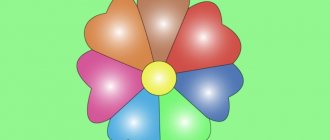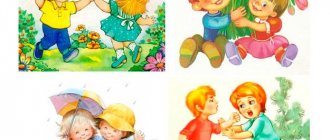Thematic day in the senior group “Sports in our lives”
Plan for the theme day “Sports in our lives” for children 5-6 years old in winter Purpose: To become familiar with the concept of sport, what importance sport has in a person’s life Age: senior group Date: mid-January Interaction of teachers: the theme day is conducted by the group’s teachers and physical education instructor The plan for the thematic day “Sport in our lives” is presented in a table.
Presented:
Regular moments: - morning reception - reading fiction - artistic and aesthetic development - physical development - afternoon Forms of work: - conversation (educator) - morning exercises (physical education instructor) - reading (educator) - drawing (educator) - walking lesson (physical education instructor) - didactic game (educator) - conversation (educator) Topics: - “What is sport” using a guest hero (Olympian Bear), illustrations about sports, literary words (Appendix 1) - Complex No. 7 with a hoop (Appendix 2) - “Two Brothers” N.Yu. Smirnova (Appendix 3) - “Children in the gym” - “Health ski track” (Appendix 4) - “Which athlete” (Appendix 5) - “What did we learn about sports today” Objectives : Conversations No. 1 1. Introduce children to the meaning sports in human life.
2. Form a positive attitude towards sports. 3. Cultivate interest in sports Morning exercises 1. Foster in children the habit of doing physical exercise every day Readings: 1. Learn to analyze the character and actions of heroes 2. Develop the ability to compare, generalize, draw conclusions 3. Form ideas about the need to play sports Drawings: 1. Learn to depict scenes from the surrounding life based on observations 2. Express in a drawing your attitude to physical education and sports Physical education classes: 1. Continue introducing children to winter sports 2. Teach sliding steps on a ski track 3. Practice the technique of descending a slope in low stand 4. Enjoy winter sports, form the habit of a healthy lifestyle Didactic game: 1. Consolidate children’s knowledge about sports, name the athlete’s equipment Conversations No. 2 1. Summarize the thematic day 2. Form the concept that playing sports is useful for human health
Applications:
Appendix 1 Conversation “What is sport” Progress of the conversation: Educator: - Guys, look who came to us. This is Olympian Bear. Hello, Mishenka. Misha the Olympian: - Good morning, guys. I came running to you from training. I want to ask you, do you know what sport is and why we need it? (children's answers) The file contains the full text of the conversation Mishka stays for morning exercises Appendix 2 The file contains a complex of gymnastics with a hoop Appendix 3 Just recently we celebrated the New Year, and this is the story I heard from N.Yu. Smirnova “Two Brothers” Once upon a time there were two boys - Vitya and Zhenya. Vitya looked like Zhenya, and Zhenya looked like Vitya like two peas in a pod, because they were twin brothers. Yes, their hair was brown, their eyes were blue, and they were the same height. But for some reason Vitya grew up cheerful, cheerful, cheerful, and Zhenya grew up sad, tired, lethargic. This happened to the brothers because one of them loved to harden himself, did exercises in the morning, and was often in the fresh air. And his brother in the morning, instead of doing morning exercises, liked to sleep longer, instead of dousing himself with cold water, he liked to eat five cakes, instead of walking, he liked to play on the computer. In general, I did anything but physical education... The file contains the full text of the story Appendix 4 Synopsis of a physical education lesson Health ski track
Part I Children, with the help of a teacher, put on skis, go to the starting position, and line up in three columns. Exercises aimed at developing a sense of balance and rhythm: 1. Spring - squat down, simultaneously swing both arms back and forth. Do it 8 times. 2. Lifting the right and left legs alternately with the ski - the leg bends at the knee. Perform 6 times with each leg. 3. Lifting the toe of the right and left ski alternately - developing dynamic balance. Perform 6 times with each leg. 4. Assume the starting position of the skier - bend your legs slightly at the knees, lean forward slightly, bend your arms at the elbows, bring them closer to the body, and group. Do it 8 times. 5. Light jumps on both legs at the same time - keep the skis parallel. Do it 8 times. Part II...
The file contains the full lesson notes
Appendix 5 Didactic game “Which athlete?” Goal: to consolidate children’s knowledge about sports, name the athlete’s equipment. Material: cards depicting equipment for various sports. Progress of the game: from the cards provided, the child chooses the equipment of a football player, hockey player, basketball player, etc., names the item, tells why it was chosen, explains why the athlete needs it
Health Week: “Sports and Children”
Relevance
In preschool childhood, the foundation of a child’s health is laid, his intensive growth and development occurs, basic movements, posture, as well as the necessary skills and habits are formed, basic physical qualities are acquired, character traits are developed, without which a healthy lifestyle is impossible.
Notations and teachings do not bring success in developing the need to be healthy in preschoolers. The best way to introduce a child to a healthy lifestyle is to show by example how to approach physical education and sports. If a child sees that their parents enjoy healthy, active leisure, they will definitely imitate them.
But only with the close support of parents can a preschool educational institution achieve positive results in raising a healthy child. We believe that the main thing is to help children develop their own life guidelines in choosing a healthy lifestyle, teach them to evaluate their physical capabilities, see the prospects for their development, and realize responsibility for their health.
Target:
Involving parents in joint active activities in matters of physical education. Creation of a comprehensive system of child upbringing and development aimed at preserving and strengthening the health of children. Formation of responsibility among parents and pupils in the form of maintaining their own health.
Tasks:
• Increasing the physical education and health literacy of parents;
• Training in health-saving technologies: developing in children knowledge, skills and abilities to maintain health and responsibility for it;
• Study the interests, opinions of parents, their hobbies and involve children in the organization of physical education;
• Enrich parent-child relationships when conducting joint events, while paying special attention to promoting a healthy lifestyle, disease prevention, preserving and strengthening the physical health of children;
• To involve parents in participating in the life of the kindergarten through the search and implementation of the most effective forms of work;
• Study the family and establish contacts with its members to coordinate educational influences on the child;
• Use the educational potential of parents to educate and raise children.
Hypothesis:
The physical qualities of children will effectively develop, and their health will be maintained and strengthened, provided that a system of work with children on physical education and health improvement is developed by preschool teachers together with the parents of the pupils.
Item:
A set of methods, techniques and other means for the development of physical qualities and the health of preschool children.
Sports in kindergarten
Sport is an essential component of every person’s life. Sports are no less important for children, including the youngest. It is necessary to instill in a child a love of sports from childhood, and the most important example for him, of course, is his parents.
Sports in kindergarten
Kindergarten is an active part of a child’s life. Coming every day to kindergarten, to a group of children, the child will learn discipline and a certain daily routine. Sports activities are necessarily included in the main kindergarten schedule. Morning exercises, sports competitions, sports festivals are the key moments necessary to accustom a child to sports from childhood.
Note: a useful section on the topic of sports in kindergarten in the educational toy store “Kindergarten”. Children's sports equipment for preschoolers.
Sports and game
Of course, you shouldn’t force a love of sports on children, especially young ones, in kindergarten. A love of physical activity should be instilled gradually and always in a playful way. Elements of competition, relay races and simply active games that can be played in the gym or in the fresh air help well in this matter.
It is also necessary for the teacher to actively participate in sports games, along with the children, thereby setting an example. Children love to follow the example of adults who are in their immediate environment. Teachers and parents become the main role models. Sports in kindergarten is the work of both adults and children.
Sports competitions
The element of competition between children is very important in kindergarten sports. You can arrange fun relay races with bright elements, for example, colorful balls, skittles, rings, jump ropes. Bright colors not only relieve the atmosphere, but also make the sport bright and interesting.
However, educators must explain to children that winning is not as important as participation in the game and team spirit.
The teacher can also tell the children about the emergence of sports competitions, for example, about the Olympic Games, which became an alternative to the war that lasted for many years. A plus will be a story about the benefits of sport, its impact on physical development and human health. The child must understand that sport is not only a compulsory activity, but also a system for healing the body.
Sports and health holidays
Organizing sports holidays in kindergarten and health holidays will also help to instill in children a love of sports, because a holiday is a holiday and it doesn’t matter at all what the reason for it will be.
There are many scenarios for holding this kind of holiday, and in addition to the usual relay races and competitions, you can organize a sports quiz or an exhibition of children's drawings on the topic of sports and health. Little artists will definitely be inspired by the theme and will try to translate their thoughts onto paper. You will find some scenarios dedicated to sports in kindergarten on our website.
Note to parents
It’s not just teachers who instill in children a love of sports. Parents should also actively participate in the child’s life and explain to him the need for physical activity. Sports should be present not only in kindergarten, but also at home!
For example: you can explain to a child that if he plays sports, runs, jumps and does exercises, he will become healthier and will be able to avoid illnesses, bitter medicines and injections.
Together with your child, you can come up with a story about the insidious Flu and Sports, who was able to defeat the disease thanks to his strength.
You need to instill a love of sports in a fun and relaxed way. In winter, it is useful to go skiing with your child, and you can do gymnastics at home. Of course, sports should be a must in kindergarten!
Little children love it when adults ask them to teach them how to do exercises that they learned in kindergarten. At such moments, children feel more authoritative and willingly teach their parents simple exercises. However, it is important not to interrupt the child and repeat all his movements exactly, then the baby will be happy, and the sport will become a pleasant pastime for him.
Author Natalya Shumaeva.



